
RookieAI_yolov8
基于yolov8实现的AI自瞄项目 AI self-aiming project based on yolov8
Stars: 340
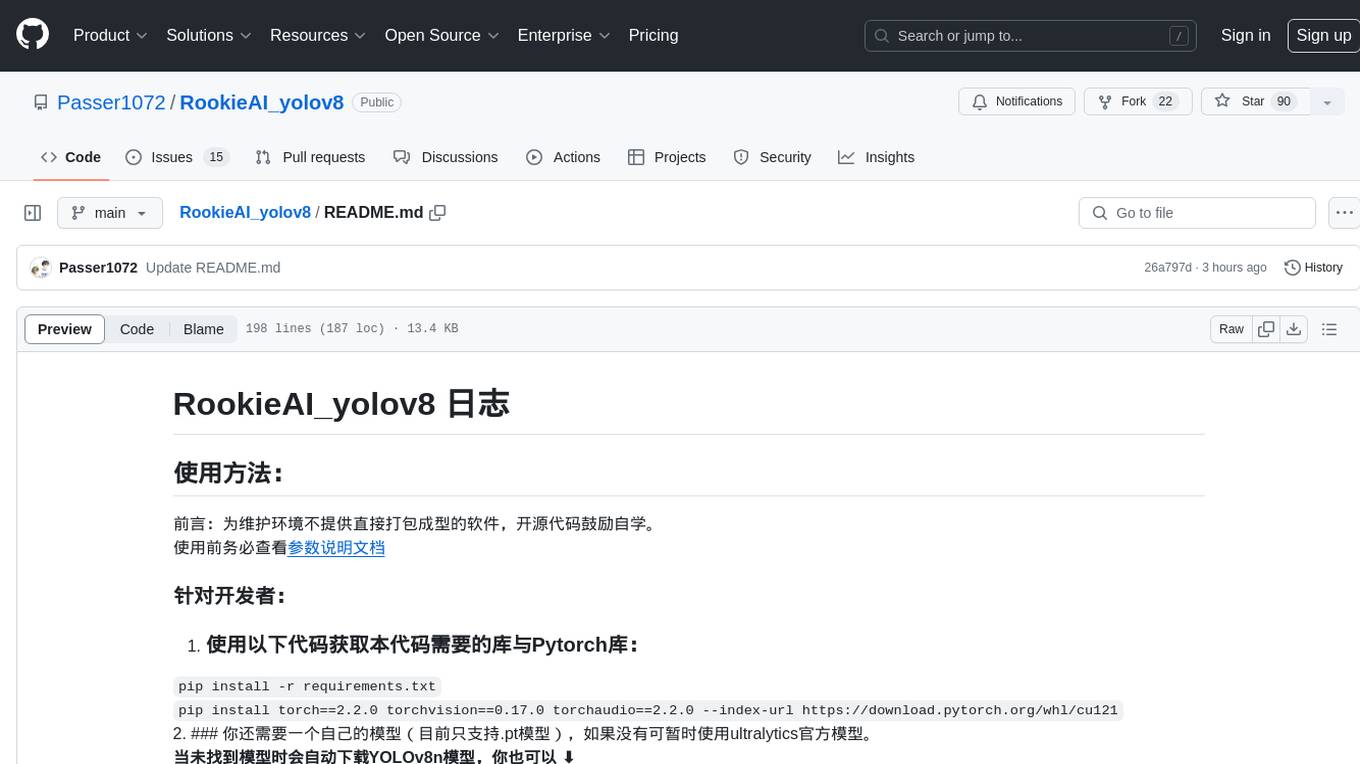
RookieAI_yolov8 is an open-source project designed for developers and users interested in utilizing YOLOv8 models for object detection tasks. The project provides instructions for setting up the required libraries and Pytorch, as well as guidance on using custom or official YOLOv8 models. Users can easily train their own models and integrate them with the software. The tool offers features for packaging the code, managing model files, and organizing the necessary resources for running the software. It also includes updates and optimizations for better performance and functionality, with a focus on FPS game aimbot functionalities. The project aims to provide a comprehensive solution for object detection tasks using YOLOv8 models.
README:
[!IMPORTANT] 使用前请先阅读参数解释文档
[!NOTE] 前言:为什么不提供直接打包成型的软件?
每个程序都有独立的特征码,如果大家都使用同一个程序,一旦其中一个人被BAN其他人会被联BAN。所以鼓励大家自行修改部分代码并自行打包即可避免此类情况发生。
| Version | Python |
|---|---|
2.4.3或更早 |
3.7+ |
2.4.4.2+ |
3.10+ |
- 使用以下代码获取本代码需要的库与Pytorch库
✨ 超高速无痛下载 ✨
pip install -r requirements.txt -i https://pypi.doubanio.com/simple/
pip uninstall torch torchvision torchaudio
pip install torch torchvision torchaudio -f https://mirror.sjtu.edu.cn/pytorch-wheels/torch_stable.html --no-index海外用户请使用以下命令
pip install -r requirements.txt
pip uninstall torch torchvision torchaudio
pip install torch torchvision torchaudio -f https://download.pytorch.org/whl/torch_stable.html --no-index-
你还需要一个自己的模型(目前支持.pt/.engine/.onnx模型),如果没有可暂时使用ultralytics官方模型
-
当未找到模型时会自动下载YOLOv8n模型,你也可以⬇️
访问YOLOv8GitHub界面获取更多官方yolov8模型以快速开始
访问ultralytics官网查看官方网站帮助文档
- 运行
在脚本所在目录打开终端,键入以下内容并回车
python RookieAI.py建议自行训练
V3.0预告
3.0版本注重使用多线程进行优化,理论上可以提升截图效率与推理效率,但是可能会导致延迟问题。当然也提供原始的单进程推理模式可供选择。
该版本从底层代码到UI界面进行了完全重构,多线程也可以带来更多使用上的优化,例如可随意调整鼠标移动的频率,不再受到推理帧数的限制等。目前测试主系统空载YOLO使用YOLO11n模型推理的帧数从55提升到了80,有明显提升。配合独立的鼠标移动进程,理论上可以带来不错的使用体验。
对电脑配置的要求也会有一定程度的降低。代码目前处于早期开发阶段,未集成Aimbot等基础功能,开发进度与源代码请稍后关注对应文档。
推荐使用Atlas游戏系统配合boosterX性能优化软件获得更好体验
AtlasOS对 Windows 进行修改,专为游戏玩家设计。具有更高的游戏帧率和更低的延迟。同时在此系统上使用RookieAI可更高效的利用GPU资源得到更高的推理帧率。
boosterX是一款系统优化软件,优化Windows,降低延迟、提高 FPS。在AtlasOS系统上使用可进一步进行优化。
配置单: 截图模式:mss 截图高/宽:320 显卡:RTX4080M 模型:YOLOv8s_TheFinals_teammate_enemy_04.engine
原版windows空载运行RookieAI2.4.3 对比 AtlasOS 空载运行RookieAI2.4.3:
此项目最初目的为Apex的Aimbot,未考虑其他游戏,可能会出现因反作弊禁止WIN32移动方式而无法使用的情况!
已知游戏:VALORANT
面对日益增多的配置文件参数,我新建了参数解释文档,里面介绍了配置文件内所有参数的信息,前往参数解释文档查看。
❗V3支持KmBoxNet,VALORANT确认可用
🎉🎉🎉非常感谢由RicardoJoaquim提供的英文特别版本🎉🎉🎉
Current latest version: ###
For Tasks:
Click tags to check more tools for each tasksFor Jobs:
Alternative AI tools for RookieAI_yolov8
Similar Open Source Tools

RookieAI_yolov8
RookieAI_yolov8 is an open-source project designed for developers and users interested in utilizing YOLOv8 models for object detection tasks. The project provides instructions for setting up the required libraries and Pytorch, as well as guidance on using custom or official YOLOv8 models. Users can easily train their own models and integrate them with the software. The tool offers features for packaging the code, managing model files, and organizing the necessary resources for running the software. It also includes updates and optimizations for better performance and functionality, with a focus on FPS game aimbot functionalities. The project aims to provide a comprehensive solution for object detection tasks using YOLOv8 models.

WeKnora
WeKnora is a document understanding and semantic retrieval framework based on large language models (LLM), designed specifically for scenarios with complex structures and heterogeneous content. The framework adopts a modular architecture, integrating multimodal preprocessing, semantic vector indexing, intelligent recall, and large model generation reasoning to build an efficient and controllable document question-answering process. The core retrieval process is based on the RAG (Retrieval-Augmented Generation) mechanism, combining context-relevant segments with language models to achieve higher-quality semantic answers. It supports various document formats, intelligent inference, flexible extension, efficient retrieval, ease of use, and security and control. Suitable for enterprise knowledge management, scientific literature analysis, product technical support, legal compliance review, and medical knowledge assistance.
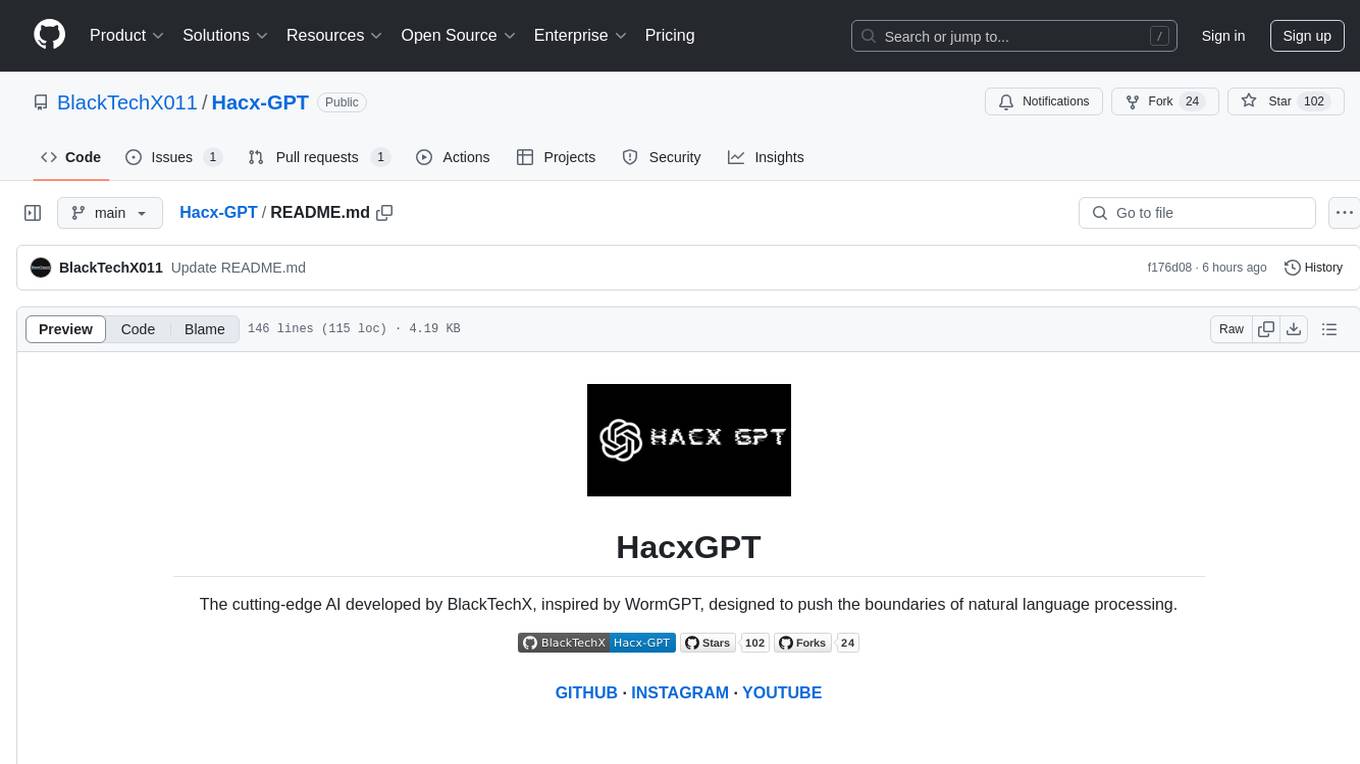
Hacx-GPT
Hacx GPT is a cutting-edge AI tool developed by BlackTechX, inspired by WormGPT, designed to push the boundaries of natural language processing. It is an advanced broken AI model that facilitates seamless and powerful interactions, allowing users to ask questions and perform various tasks. The tool has been rigorously tested on platforms like Kali Linux, Termux, and Ubuntu, offering powerful AI conversations and the ability to do anything the user wants. Users can easily install and run Hacx GPT on their preferred platform to explore its vast capabilities.
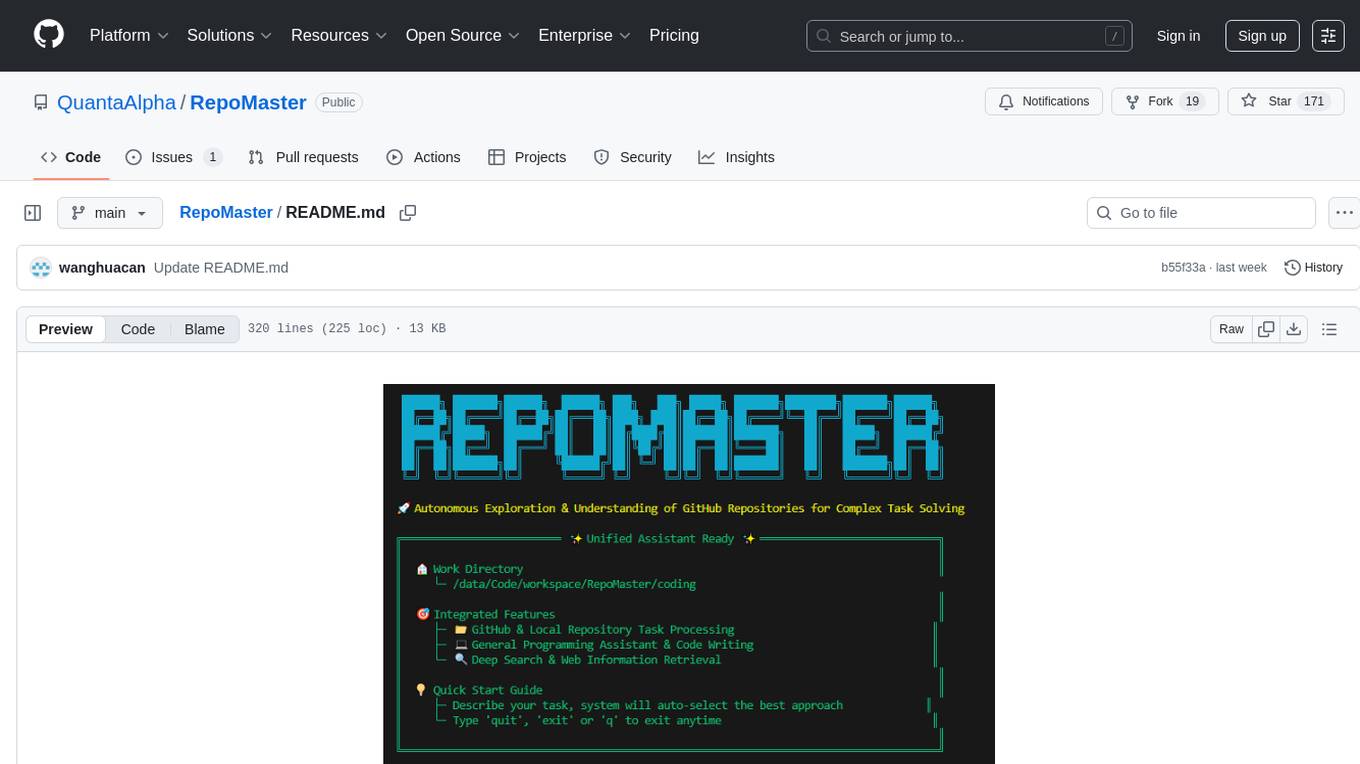
RepoMaster
RepoMaster is an AI agent that leverages GitHub repositories to solve complex real-world tasks. It transforms how coding tasks are solved by automatically finding the right GitHub tools and making them work together seamlessly. Users can describe their tasks, and RepoMaster's AI analysis leads to auto discovery and smart execution, resulting in perfect outcomes. The tool provides a web interface for beginners and a command-line interface for advanced users, along with specialized agents for deep search, general assistance, and repository tasks.
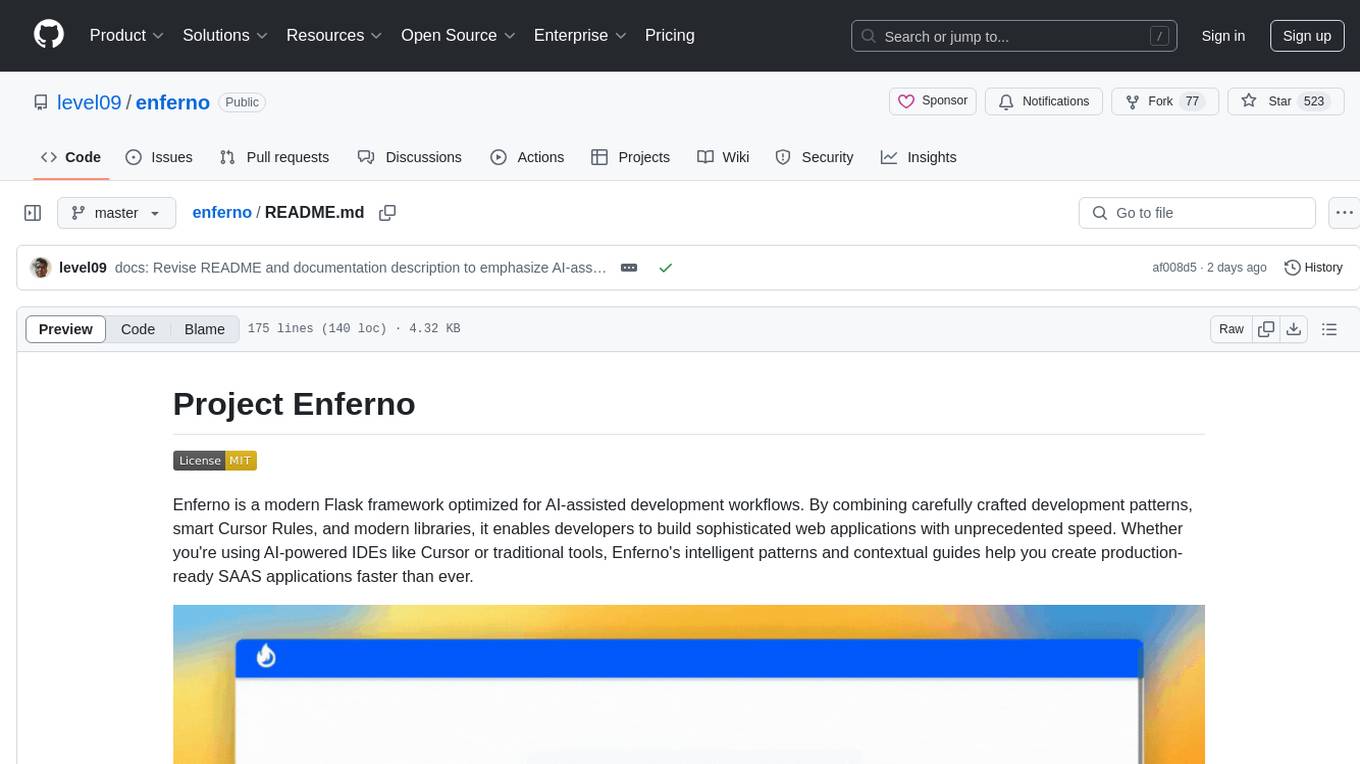
enferno
Enferno is a modern Flask framework optimized for AI-assisted development workflows. It combines carefully crafted development patterns, smart Cursor Rules, and modern libraries to enable developers to build sophisticated web applications with unprecedented speed. Enferno's intelligent patterns and contextual guides help create production-ready SAAS applications faster than ever. It includes features like modern stack, authentication, OAuth integration, database support, task queue, frontend components, security measures, Docker readiness, and more.
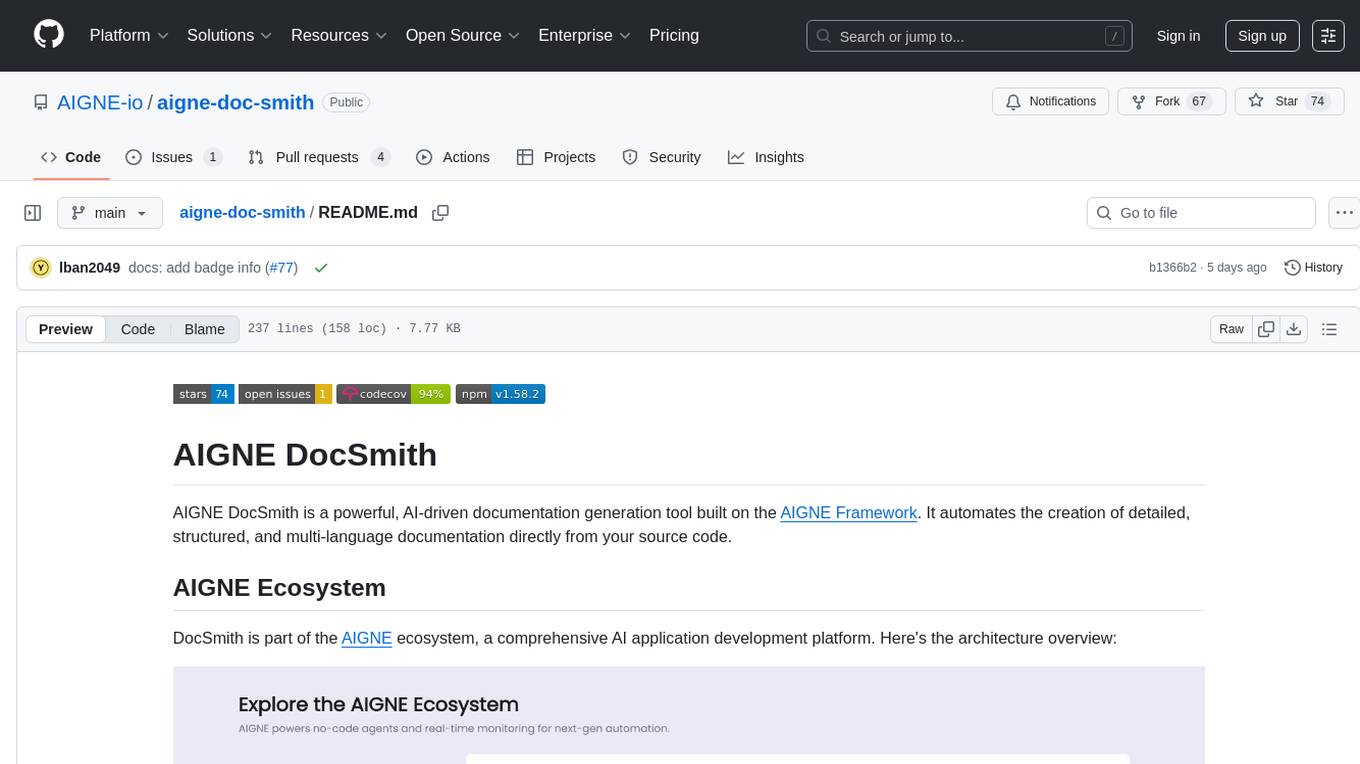
aigne-doc-smith
AIGNE DocSmith is a powerful AI-driven documentation generation tool that automates the creation of detailed, structured, and multi-language documentation directly from source code. It intelligently analyzes codebase to generate a comprehensive document structure, populates content with high-quality AI-powered generation, supports seamless translation into 12+ languages, integrates with AIGNE Hub for large language models, offers Discuss Kit publishing, automatically updates documentation with source code changes, and allows for individual document optimization.
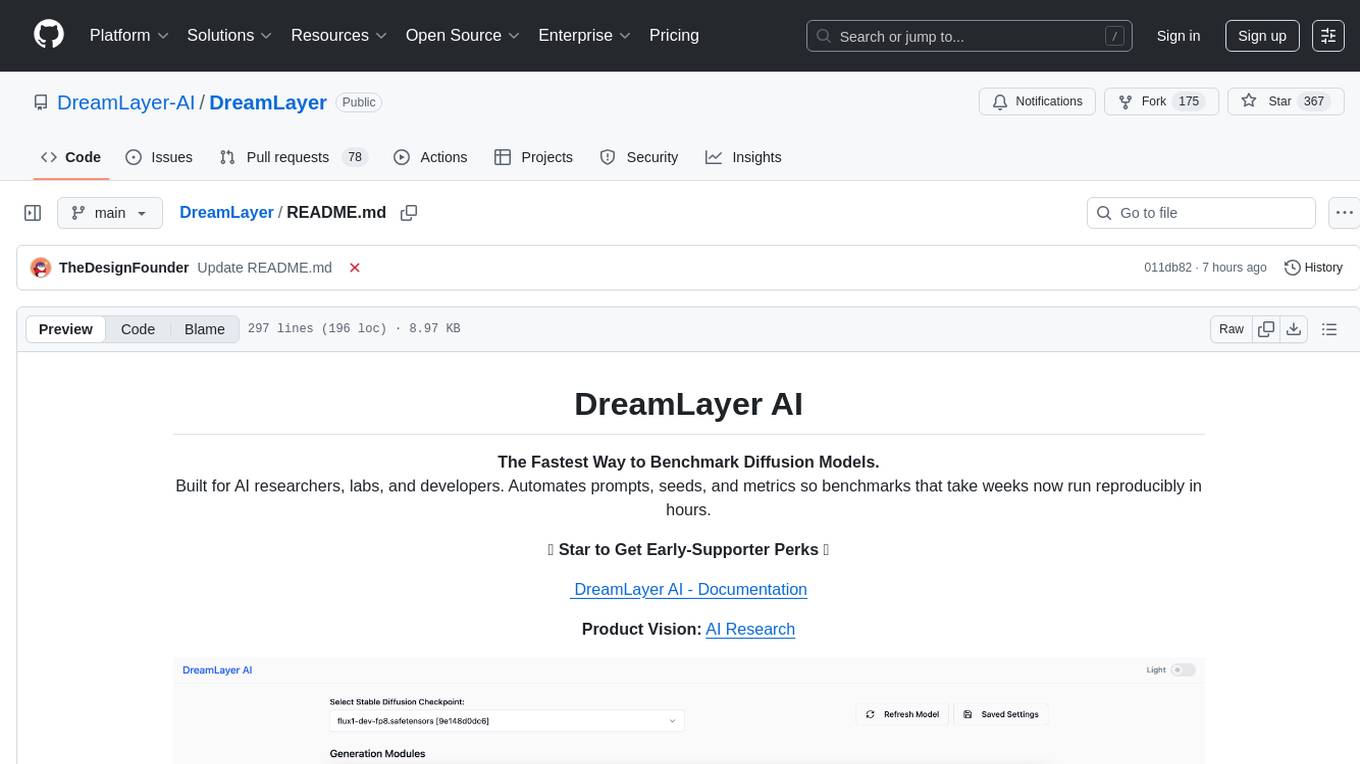
DreamLayer
DreamLayer AI is an open-source Stable Diffusion WebUI designed for AI researchers, labs, and developers. It automates prompts, seeds, and metrics for benchmarking models, datasets, and samplers, enabling reproducible evaluations across multiple seeds and configurations. The tool integrates custom metrics and evaluation pipelines, providing a streamlined workflow for AI research. With features like automated benchmarking, reproducibility, built-in metrics, multi-modal readiness, and researcher-friendly interface, DreamLayer AI aims to simplify and accelerate the model evaluation process.
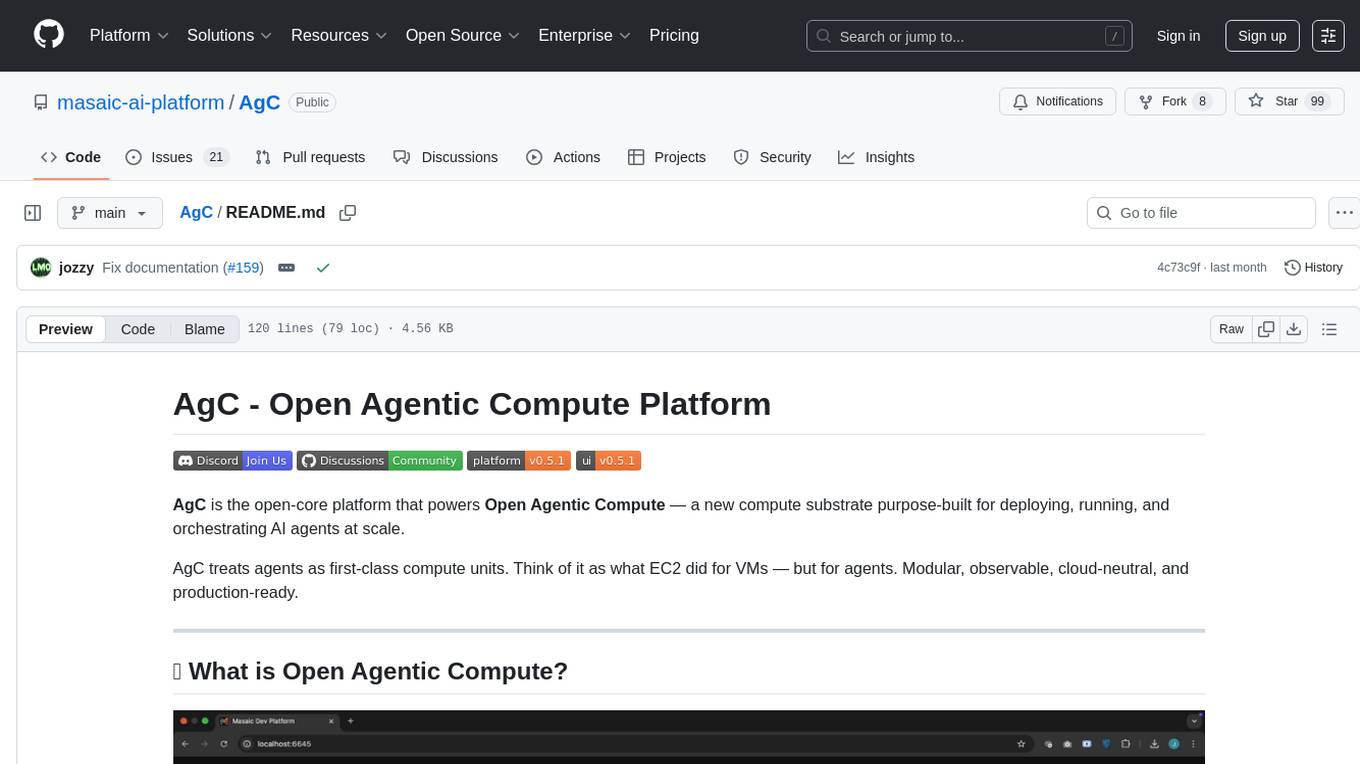
AgC
AgC is an open-core platform designed for deploying, running, and orchestrating AI agents at scale. It treats agents as first-class compute units, providing a modular, observable, cloud-neutral, and production-ready environment. Open Agentic Compute empowers developers and organizations to run agents like cloud-native workloads without lock-in.
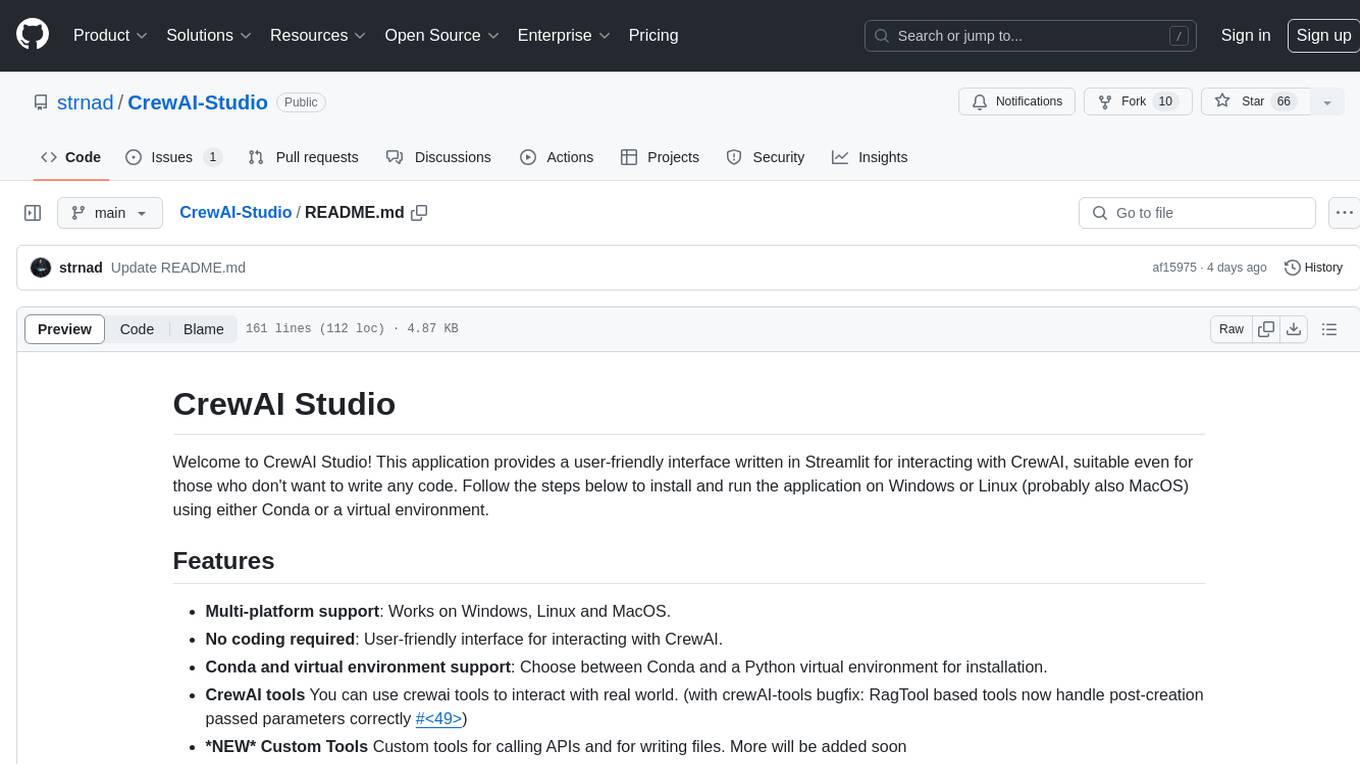
CrewAI-Studio
CrewAI Studio is an application with a user-friendly interface for interacting with CrewAI, offering support for multiple platforms and various backend providers. It allows users to run crews in the background, export single-page apps, and use custom tools for APIs and file writing. The roadmap includes features like better import/export, human input, chat functionality, automatic crew creation, and multiuser environment support.
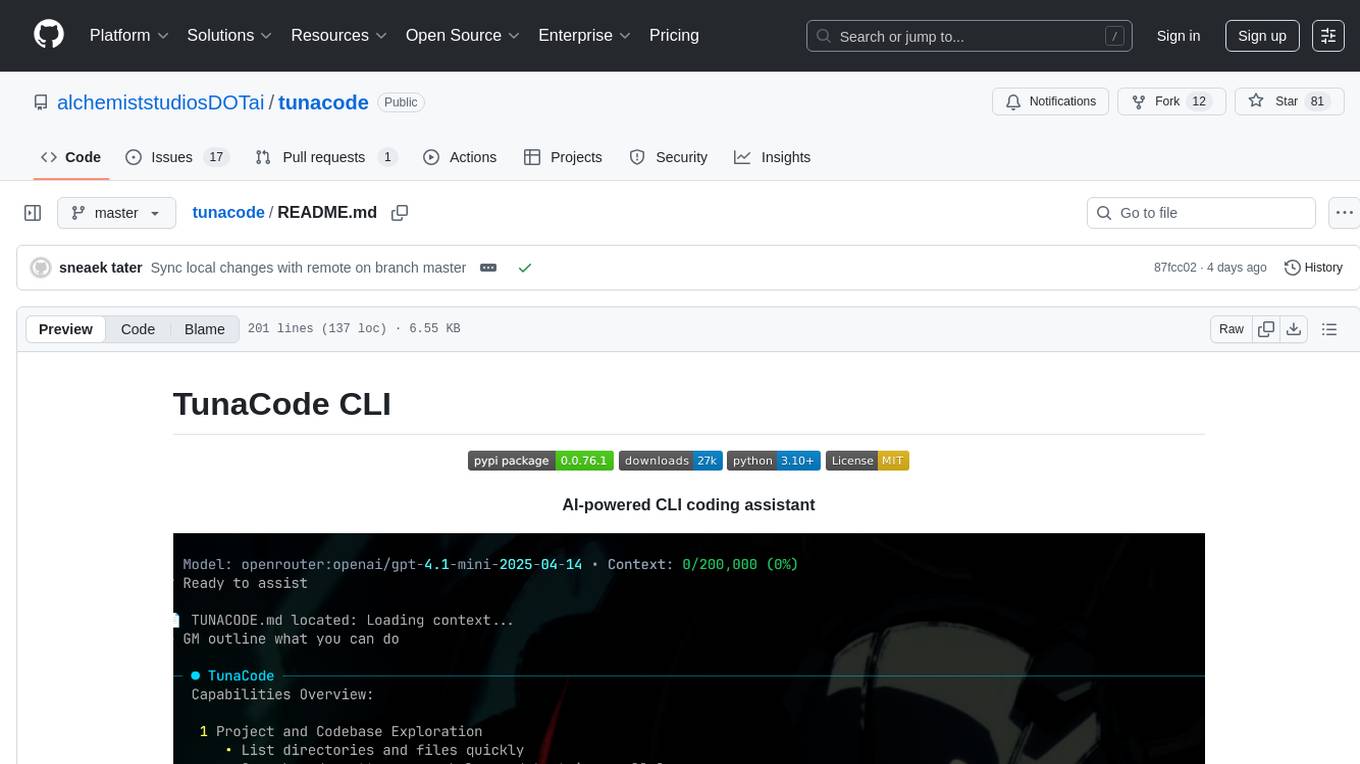
tunacode
TunaCode CLI is an AI-powered coding assistant that provides a command-line interface for developers to enhance their coding experience. It offers features like model selection, parallel execution for faster file operations, and various commands for code management. The tool aims to improve coding efficiency and provide a seamless coding environment for developers.
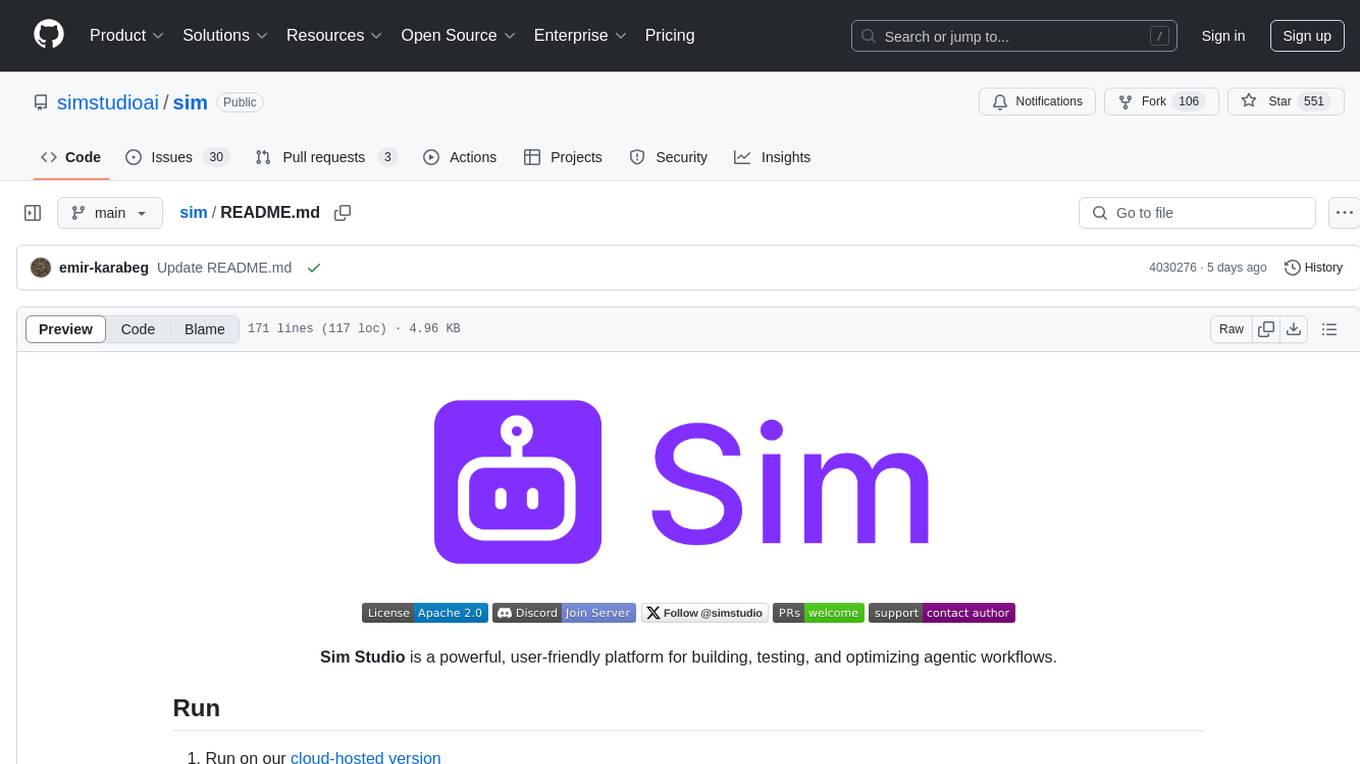
sim
Sim is a platform that allows users to build and deploy AI agent workflows quickly and easily. It provides cloud-hosted and self-hosted options, along with support for local AI models. Users can set up the application using Docker Compose, Dev Containers, or manual setup with PostgreSQL and pgvector extension. The platform utilizes technologies like Next.js, Bun, PostgreSQL with Drizzle ORM, Better Auth for authentication, Shadcn and Tailwind CSS for UI, Zustand for state management, ReactFlow for flow editor, Fumadocs for documentation, Turborepo for monorepo management, Socket.io for real-time communication, and Trigger.dev for background jobs.
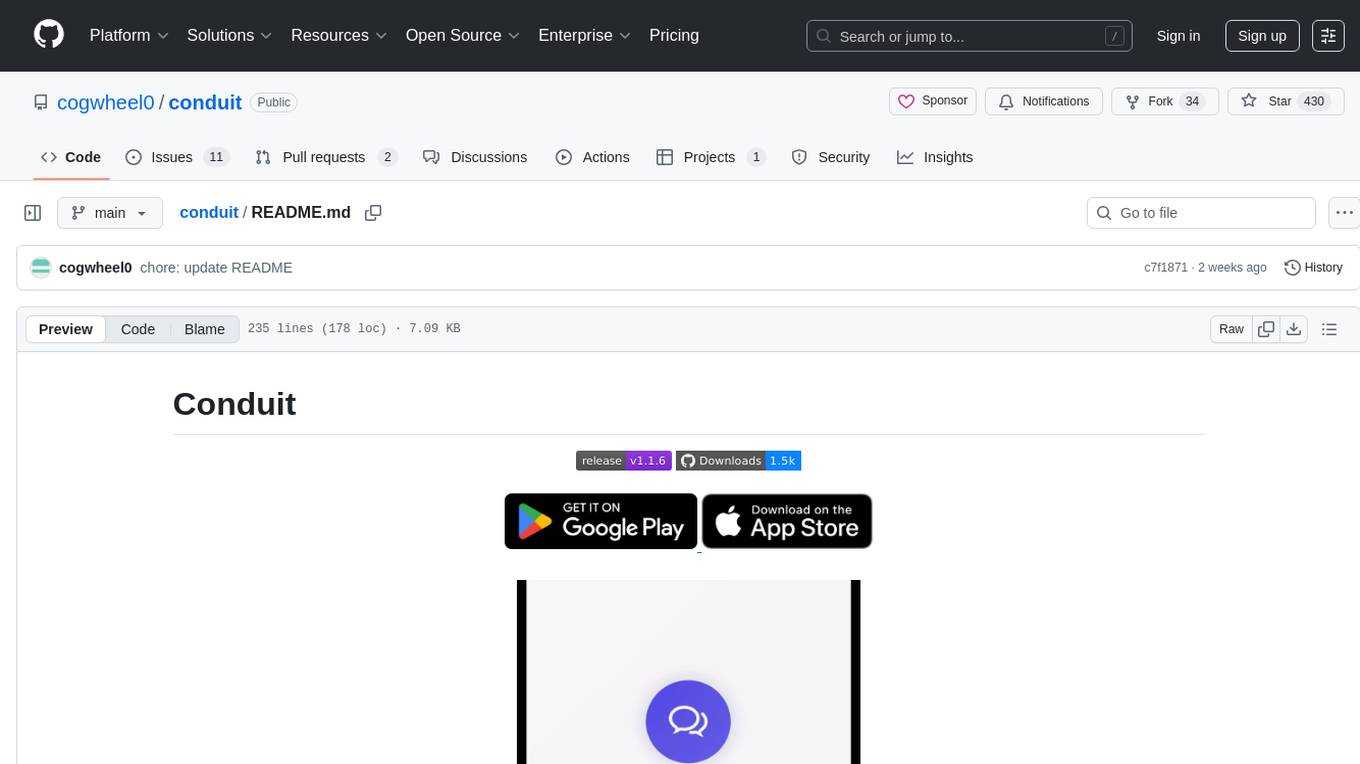
conduit
Conduit is an open-source, cross-platform mobile application for Open-WebUI, providing a native mobile experience for interacting with your self-hosted AI infrastructure. It supports real-time chat, model selection, conversation management, markdown rendering, theme support, voice input, file uploads, multi-modal support, secure storage, folder management, and tools invocation. Conduit offers multiple authentication flows and follows a clean architecture pattern with Riverpod for state management, Dio for HTTP networking, WebSocket for real-time streaming, and Flutter Secure Storage for credential management.
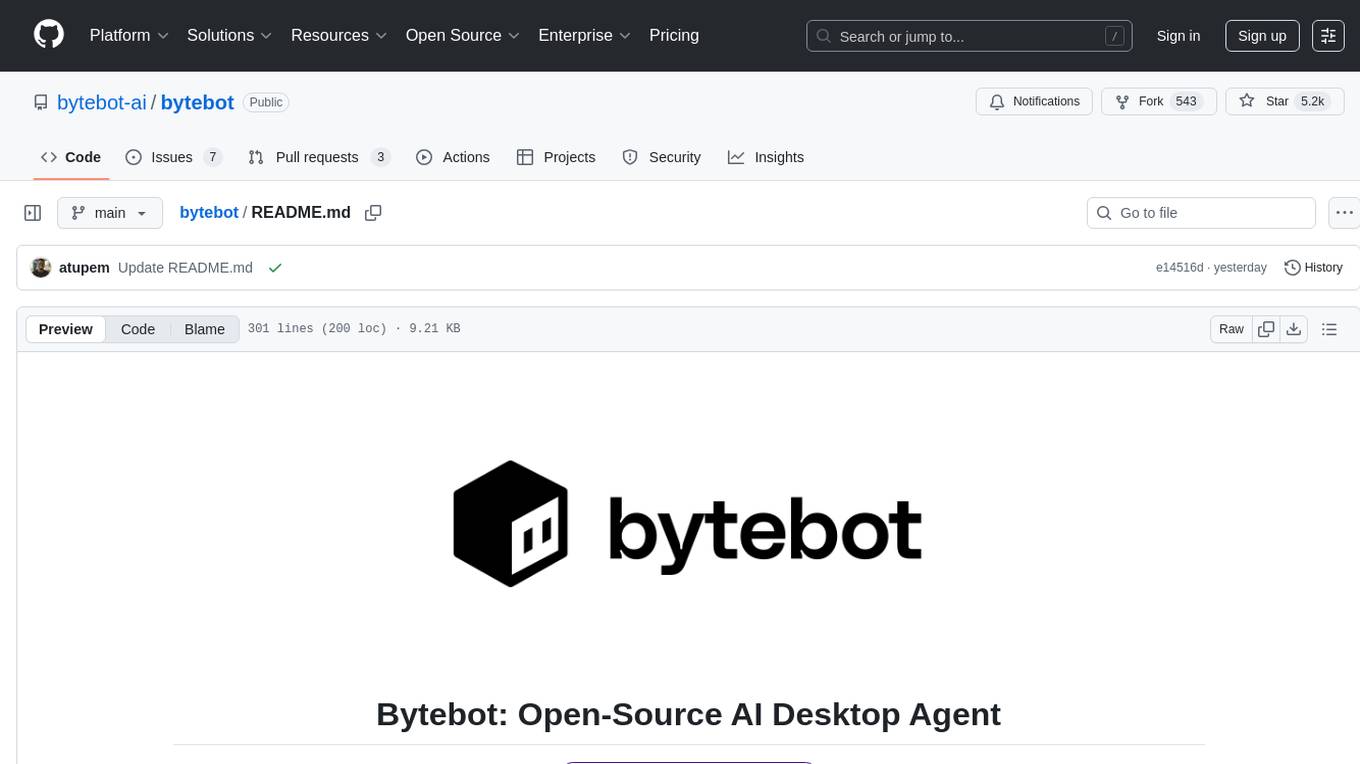
bytebot
Bytebot is an open-source AI desktop agent that provides a virtual employee with its own computer to complete tasks for users. It can use various applications, download and organize files, log into websites, process documents, and perform complex multi-step workflows. By giving AI access to a complete desktop environment, Bytebot unlocks capabilities not possible with browser-only agents or API integrations, enabling complete task autonomy, document processing, and usage of real applications.
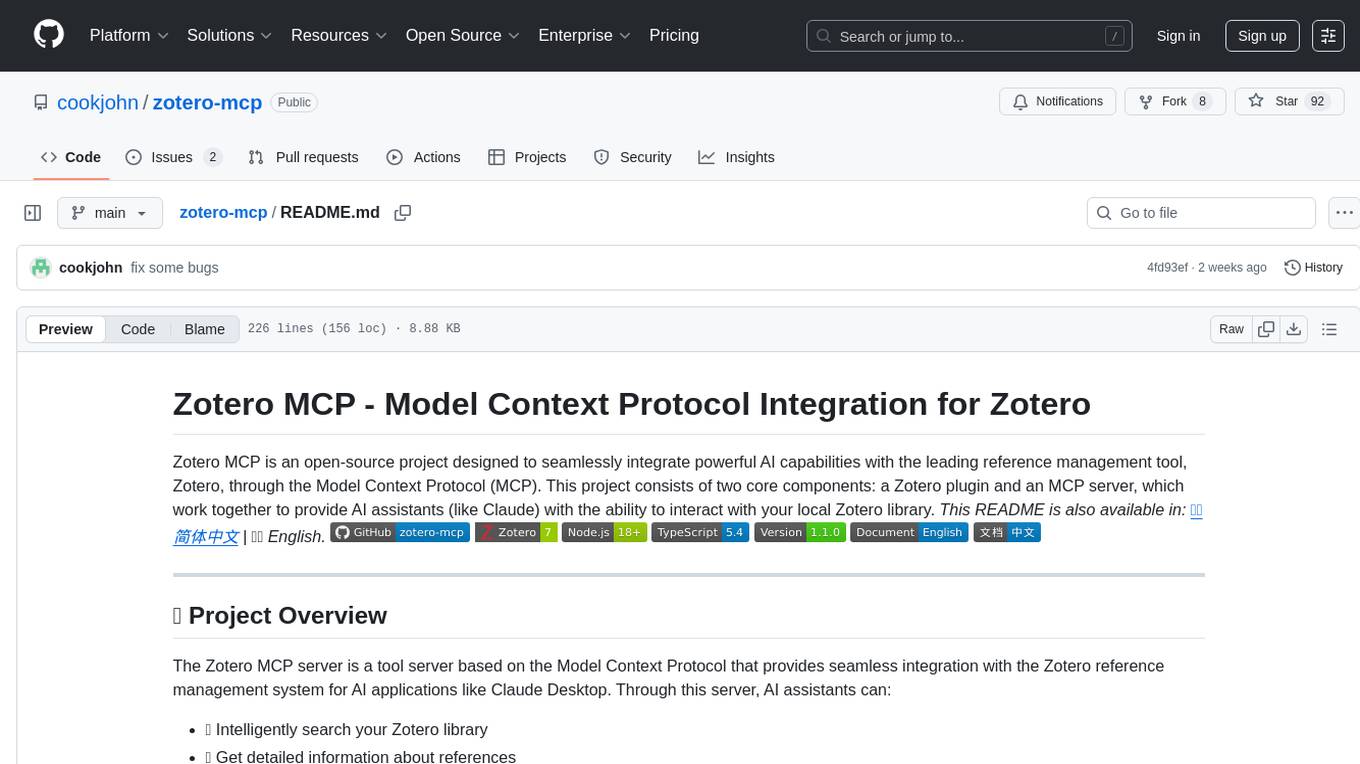
zotero-mcp
Zotero MCP is an open-source project that integrates AI capabilities with Zotero using the Model Context Protocol. It consists of a Zotero plugin and an MCP server, enabling AI assistants to search, retrieve, and cite references from Zotero library. The project features a unified architecture with an integrated MCP server, eliminating the need for a separate server process. It provides features like intelligent search, detailed reference information, filtering by tags and identifiers, aiding in academic tasks such as literature reviews and citation management.
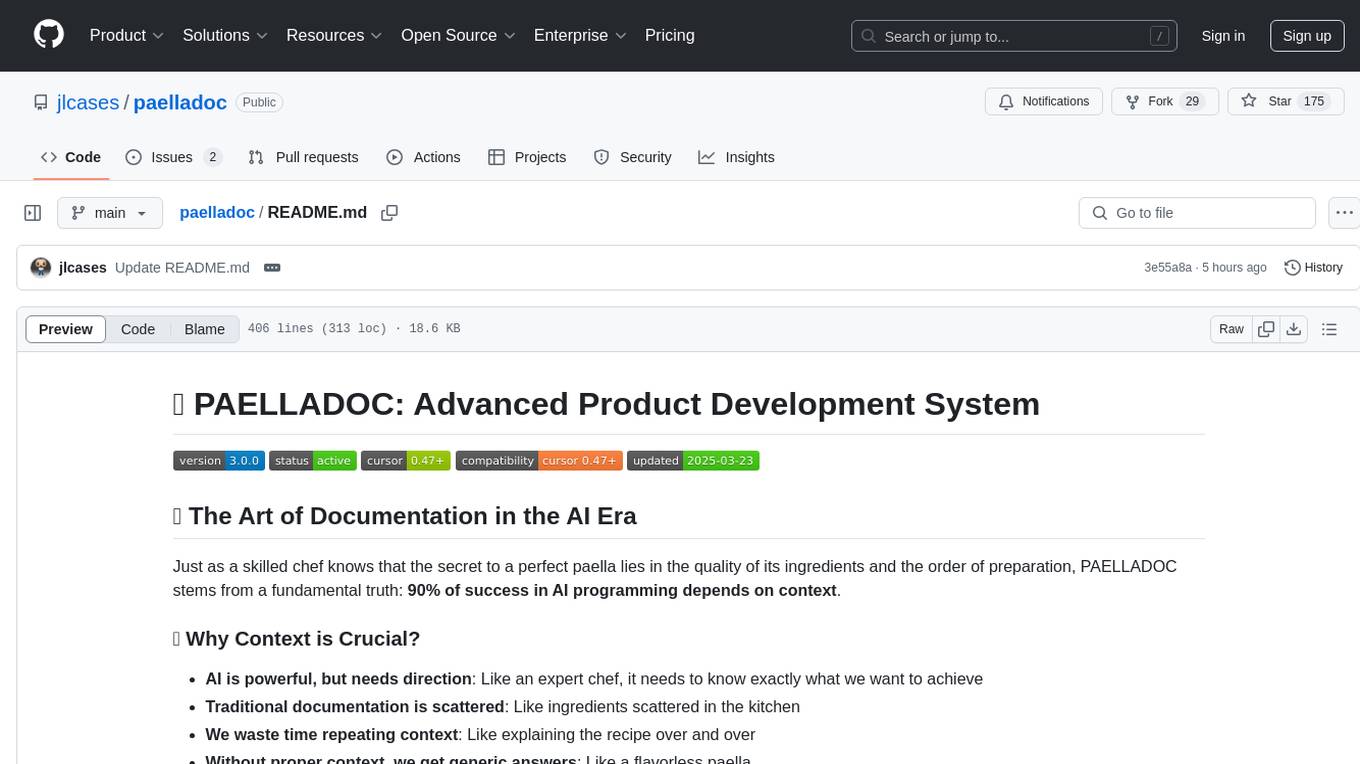
paelladoc
PAELLADOC is an intelligent documentation system that uses AI to analyze code repositories and generate comprehensive technical documentation. It offers a modular architecture with MECE principles, interactive documentation process, key features like Orchestrator and Commands, and a focus on context for successful AI programming. The tool aims to streamline documentation creation, code generation, and product management tasks for software development teams, providing a definitive standard for AI-assisted development documentation.

astrsk
astrsk is a tool that pushes the boundaries of AI storytelling by offering advanced AI agents, customizable response formatting, and flexible prompt editing for immersive roleplaying experiences. It provides complete AI agent control, a visual flow editor for conversation flows, and ensures 100% local-first data storage. The tool is true cross-platform with support for various AI providers and modern technologies like React, TypeScript, and Tailwind CSS. Coming soon features include cross-device sync, enhanced session customization, and community features.
For similar tasks

RookieAI_yolov8
RookieAI_yolov8 is an open-source project designed for developers and users interested in utilizing YOLOv8 models for object detection tasks. The project provides instructions for setting up the required libraries and Pytorch, as well as guidance on using custom or official YOLOv8 models. Users can easily train their own models and integrate them with the software. The tool offers features for packaging the code, managing model files, and organizing the necessary resources for running the software. It also includes updates and optimizations for better performance and functionality, with a focus on FPS game aimbot functionalities. The project aims to provide a comprehensive solution for object detection tasks using YOLOv8 models.

VisionCraft
The VisionCraft API is a free API for using over 100 different AI models. From images to sound.
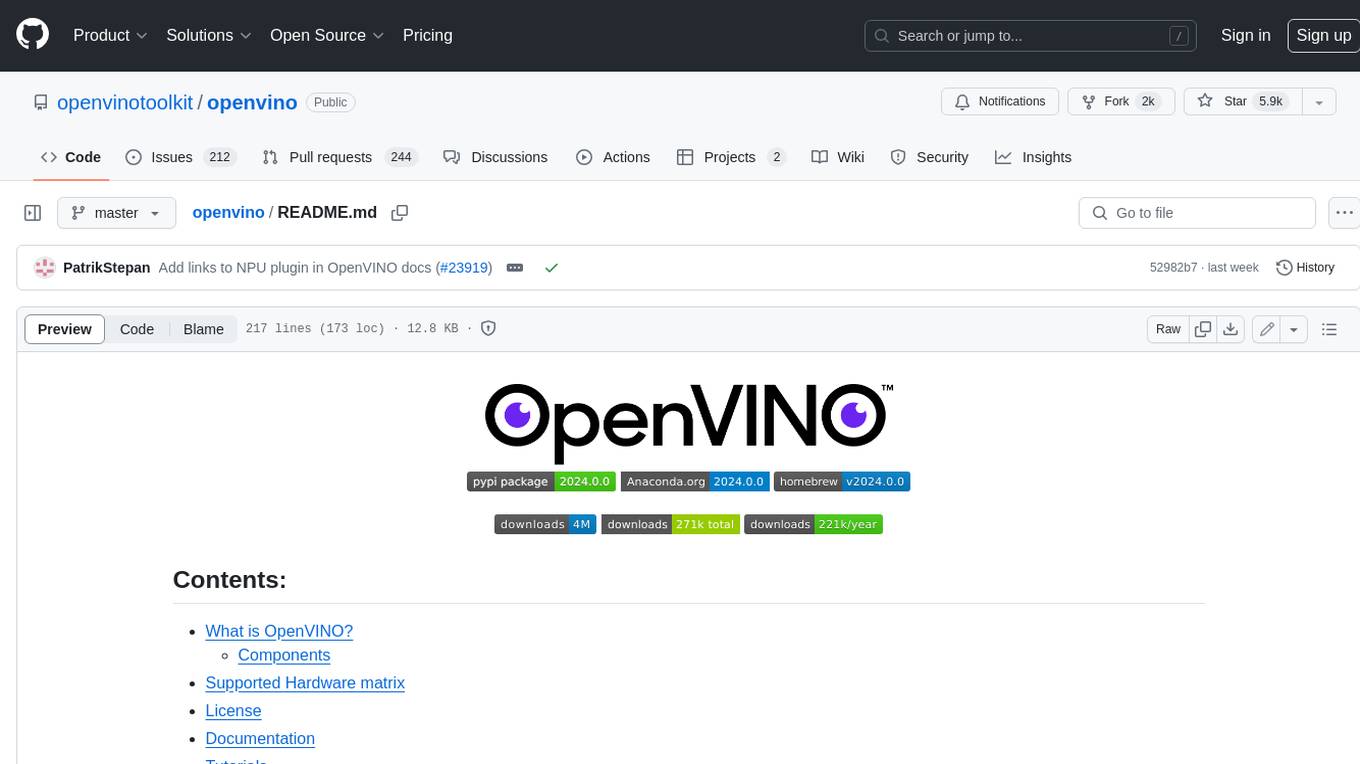
openvino
OpenVINO™ is an open-source toolkit for optimizing and deploying AI inference. It provides a common API to deliver inference solutions on various platforms, including CPU, GPU, NPU, and heterogeneous devices. OpenVINO™ supports pre-trained models from Open Model Zoo and popular frameworks like TensorFlow, PyTorch, and ONNX. Key components of OpenVINO™ include the OpenVINO™ Runtime, plugins for different hardware devices, frontends for reading models from native framework formats, and the OpenVINO Model Converter (OVC) for adjusting models for optimal execution on target devices.

djl-demo
The Deep Java Library (DJL) is a framework-agnostic Java API for deep learning. It provides a unified interface to popular deep learning frameworks such as TensorFlow, PyTorch, and MXNet. DJL makes it easy to develop deep learning applications in Java, and it can be used for a variety of tasks, including image classification, object detection, natural language processing, and speech recognition.
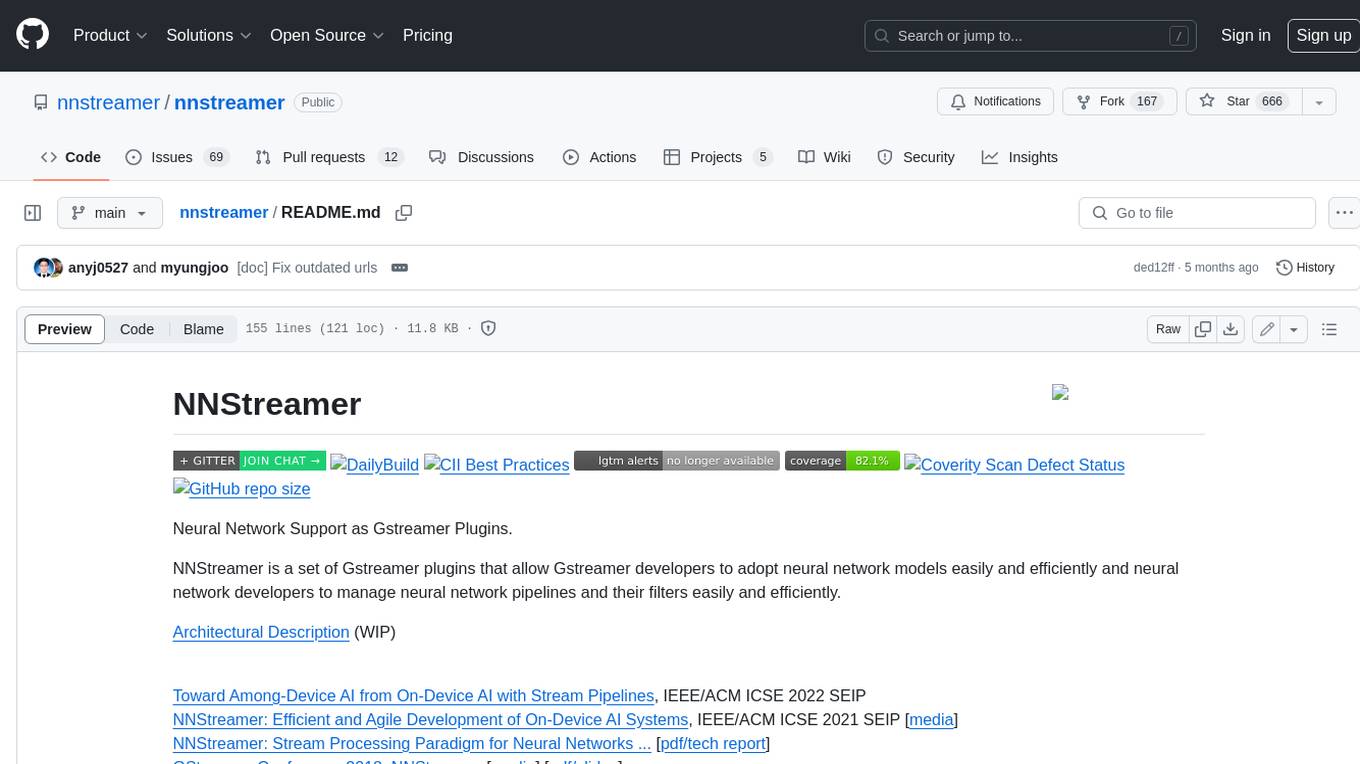
nnstreamer
NNStreamer is a set of Gstreamer plugins that allow Gstreamer developers to adopt neural network models easily and efficiently and neural network developers to manage neural network pipelines and their filters easily and efficiently.
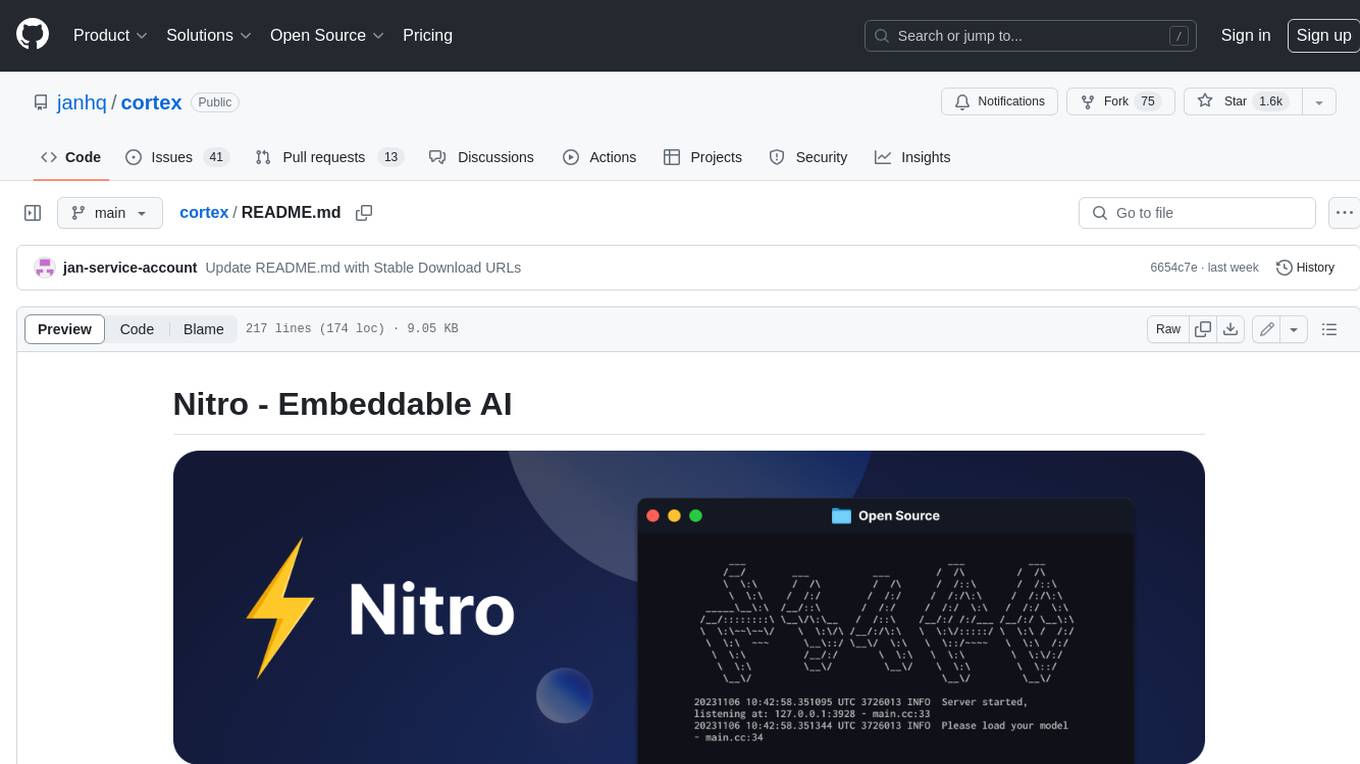
cortex
Nitro is a high-efficiency C++ inference engine for edge computing, powering Jan. It is lightweight and embeddable, ideal for product integration. The binary of nitro after zipped is only ~3mb in size with none to minimal dependencies (if you use a GPU need CUDA for example) make it desirable for any edge/server deployment.
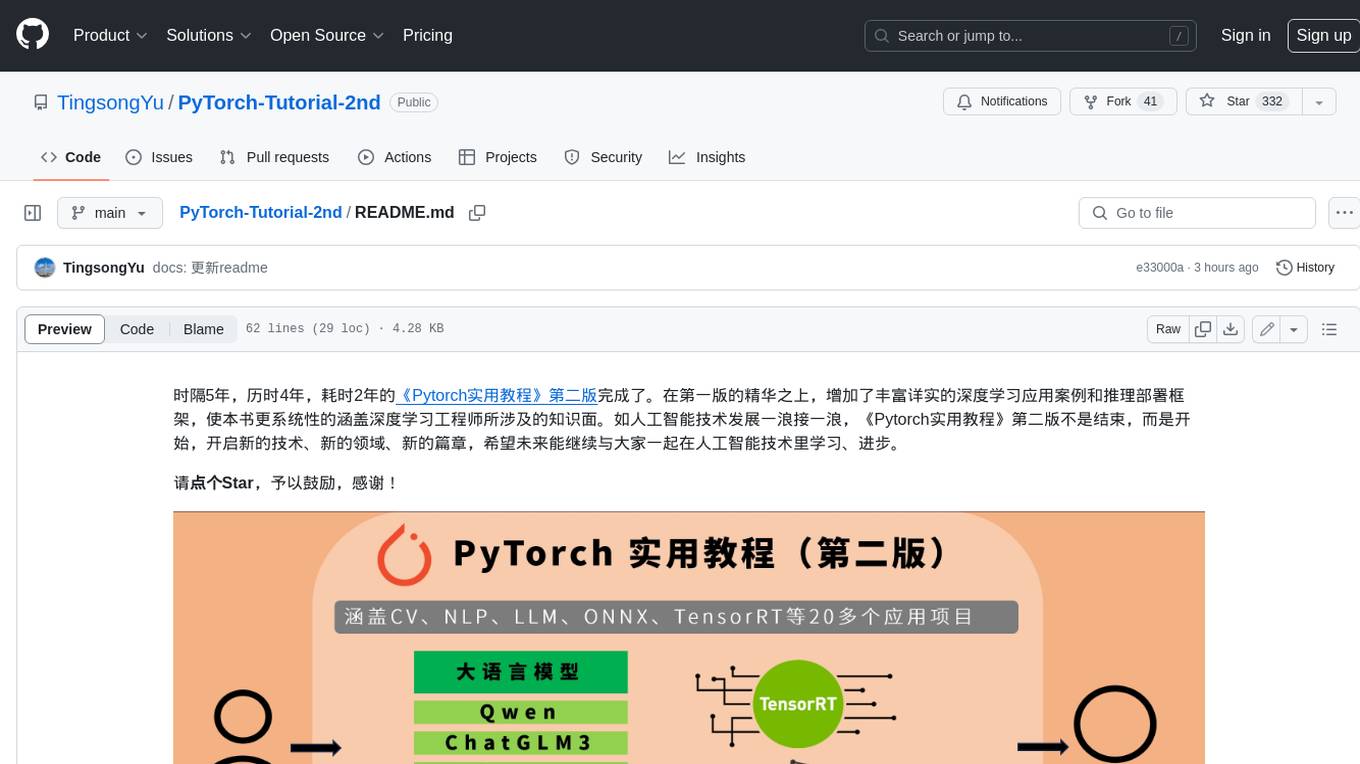
PyTorch-Tutorial-2nd
The second edition of "PyTorch Practical Tutorial" was completed after 5 years, 4 years, and 2 years. On the basis of the essence of the first edition, rich and detailed deep learning application cases and reasoning deployment frameworks have been added, so that this book can more systematically cover the knowledge involved in deep learning engineers. As the development of artificial intelligence technology continues to emerge, the second edition of "PyTorch Practical Tutorial" is not the end, but the beginning, opening up new technologies, new fields, and new chapters. I hope to continue learning and making progress in artificial intelligence technology with you in the future.
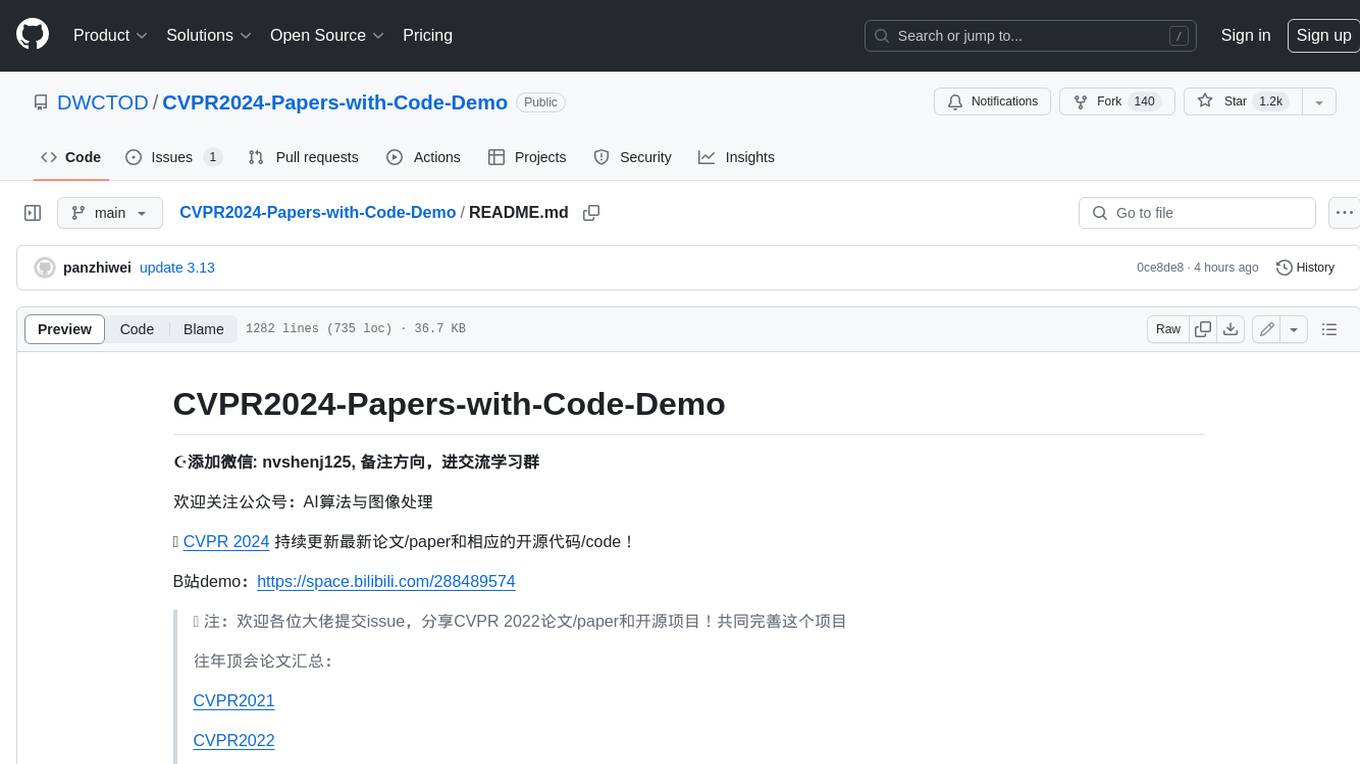
CVPR2024-Papers-with-Code-Demo
This repository contains a collection of papers and code for the CVPR 2024 conference. The papers cover a wide range of topics in computer vision, including object detection, image segmentation, image generation, and video analysis. The code provides implementations of the algorithms described in the papers, making it easy for researchers and practitioners to reproduce the results and build upon the work of others. The repository is maintained by a team of researchers at the University of California, Berkeley.
For similar jobs

weave
Weave is a toolkit for developing Generative AI applications, built by Weights & Biases. With Weave, you can log and debug language model inputs, outputs, and traces; build rigorous, apples-to-apples evaluations for language model use cases; and organize all the information generated across the LLM workflow, from experimentation to evaluations to production. Weave aims to bring rigor, best-practices, and composability to the inherently experimental process of developing Generative AI software, without introducing cognitive overhead.

LLMStack
LLMStack is a no-code platform for building generative AI agents, workflows, and chatbots. It allows users to connect their own data, internal tools, and GPT-powered models without any coding experience. LLMStack can be deployed to the cloud or on-premise and can be accessed via HTTP API or triggered from Slack or Discord.

VisionCraft
The VisionCraft API is a free API for using over 100 different AI models. From images to sound.

kaito
Kaito is an operator that automates the AI/ML inference model deployment in a Kubernetes cluster. It manages large model files using container images, avoids tuning deployment parameters to fit GPU hardware by providing preset configurations, auto-provisions GPU nodes based on model requirements, and hosts large model images in the public Microsoft Container Registry (MCR) if the license allows. Using Kaito, the workflow of onboarding large AI inference models in Kubernetes is largely simplified.

PyRIT
PyRIT is an open access automation framework designed to empower security professionals and ML engineers to red team foundation models and their applications. It automates AI Red Teaming tasks to allow operators to focus on more complicated and time-consuming tasks and can also identify security harms such as misuse (e.g., malware generation, jailbreaking), and privacy harms (e.g., identity theft). The goal is to allow researchers to have a baseline of how well their model and entire inference pipeline is doing against different harm categories and to be able to compare that baseline to future iterations of their model. This allows them to have empirical data on how well their model is doing today, and detect any degradation of performance based on future improvements.

tabby
Tabby is a self-hosted AI coding assistant, offering an open-source and on-premises alternative to GitHub Copilot. It boasts several key features: * Self-contained, with no need for a DBMS or cloud service. * OpenAPI interface, easy to integrate with existing infrastructure (e.g Cloud IDE). * Supports consumer-grade GPUs.

spear
SPEAR (Simulator for Photorealistic Embodied AI Research) is a powerful tool for training embodied agents. It features 300 unique virtual indoor environments with 2,566 unique rooms and 17,234 unique objects that can be manipulated individually. Each environment is designed by a professional artist and features detailed geometry, photorealistic materials, and a unique floor plan and object layout. SPEAR is implemented as Unreal Engine assets and provides an OpenAI Gym interface for interacting with the environments via Python.

Magick
Magick is a groundbreaking visual AIDE (Artificial Intelligence Development Environment) for no-code data pipelines and multimodal agents. Magick can connect to other services and comes with nodes and templates well-suited for intelligent agents, chatbots, complex reasoning systems and realistic characters.

